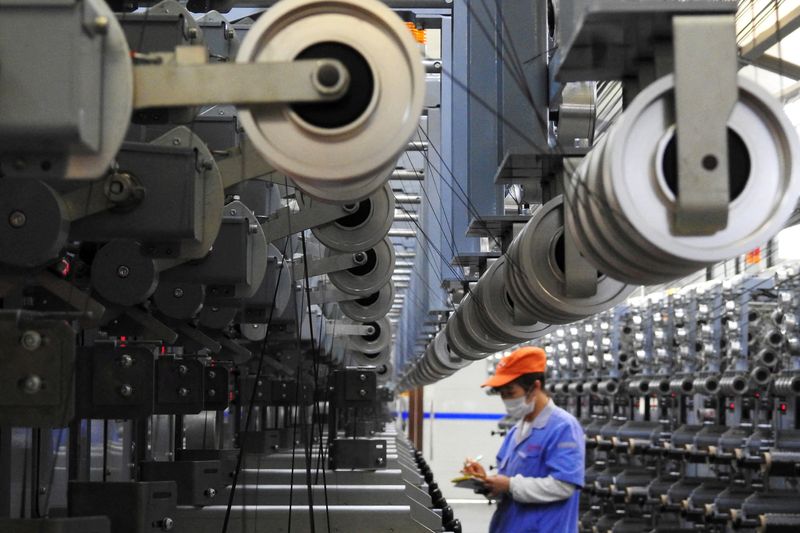
© Reuters. FILE PHOTO: An employee works at a carbon fibre production line inside a factory in Lianyungang, Jiangsu province, China October 27, 2018. REUTERS/Stringer
By Leika Kihara
TOKYO (Reuters) – Asia’s factory activity weakened in March as soft overseas demand hurt output, surveys showed on Monday, suggesting that a deteriorating global outlook will remain a drag on the region’s recovery and keep policymakers on their toes.
Export-reliant Japan and South Korea both saw manufacturing activity contract in March while growth in China stalled, highlighting the challenge facing Asia as authorities try to keep inflation in check and fend off headwinds from slackening global economic momentum.
“With global growth set to remain weak in the coming quarters, we expect manufacturing output in Asia to remain under pressure,” said Shivaan Tandon, emerging Asia economist at Capital Economics.
China’s Caixin/S&P Global manufacturing purchasing managers’ index (PMI) stood at 50.0 in March, much lower than market forecasts of 51.7 and below February’s 51.6.
The reading, which echoed slower growth in an official PMI released on Friday, put the index at the 50-point line that separates growth from contraction.
“The foundation for economic recovery is not yet solid. Looking forward, economic growth will still rely on a boost in domestic demand, especially an improvement in household consumption,” Wang Zhe, senior economist at Caixin Insight Group, said on China’s PMI.
South Korea’s PMI fell to 47.6 in March from 48.5 in February, contracting at the fastest pace in six months as export orders took a hit from weak global demand.
Japan’s final au Jibun Bank PMI stood at 49.2 in March, up from February’s 47.7 but remaining below the 50-threshold, as new orders contracted for a ninth consecutive month.
A separate central bank survey released on Monday showed Japanese big manufacturers’ sentiment soured in January-March to its worst level in more than two years, as weak external demand added to the struggle for firms already grappling with rising raw material costs.
Vietnam and Malaysia saw factory activity shrink in March, while that of the Philippines expanded at a slower pace than in February, surveys showed.
While supply disruptions caused by the COVID-19 pandemic have mostly run their course, weak chip demand and fresh signs of slowdown in global growth have emerged as risks to many Asian economies.
The collapse last month of two U.S. banks and the take-over of Credit Suisse have added to uncertainty over the global outlook by causing market turbulence and shedding light on potential vulnerabilities in the world financial system.
While indications are that the U.S. Federal Reserve will pause its tightening cycle soon, the outlook remains clouded by the banking-sector troubles, still-high inflation and slowing global growth.
The external pressures and uncertainty leave some of the major export-driven economies in Asia vulnerable at a time when businesses are looking to bounce back after a years-long COVID-induced downturn.
“Given much of the drag from higher interest rates is yet to feed through to advanced economies, we expect global growth and demand for Asia’s exports to remain weak in the coming quarters,” Capital Economics’ Tandon said.





